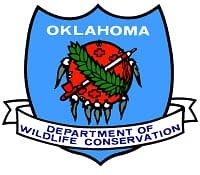Oklahoma Record Bass Stocking Effort Gives 44 Lakes a Genetic Boost

Over a three-week period this spring, the Fisheries Division of the Oklahoma Department of Wildlife Conservation released a record-setting 2.22 million Florida-strain largemouth bass (FLMB) into 44 Oklahoma lakes.
This year’s exceptional FLMB production at three of the state’s fish hatcheries doubled what would be expected in an average year, said Cliff Sager, a senior biologist with the Wildlife Department.
“We had a good situation this year by having so many fish,” Sager said, which resulted in many more lakes being stocked than would have been stocked in an average year.
“Being able to stock 44 lakes, to give so many lakes a shot in the arm with the Florida genetics, that just increased the potential for trophy bass production for years to come.”
Ike McKay, FMLB project leader at the Durant State Fish Hatchery, credits better spawning and handling techniques being used by hatchery technicians as being one major reason for this year’s bumper crop of FMLB. Improved techniques have allowed record fish production the past two years, and McKay credits “the commitment and cooperation of everyone involved.”
The outstanding numbers from 2013 eclipsed the previous production record set in 2012, when the Fisheries Division stocked 1.74 million FLMB in 27 state lakes.
The Wildlife Department began stocking Florida-strain bass in Oklahoma waters in the 1970s, with the goal of introducing the strain’s genetics into local populations.
The Florida bass grow larger than native strains, but they also are not as tolerant of cooler temperatures.
“Oklahoma is really right on the line of where you can expect Florida bass to be successful,” Sager said. Lakes in the southern half of Oklahoma have shown much greater success in sustaining Florida-strain bass. “There’s a reason Cedar Lake (in southeastern Oklahoma) has broken the state record the past two years.”
Stocking sites are chosen by a committee of biologists and technicians based on many criteria. The committee considers the documented success in trophy bass production, as well as angler pressure. Also, lakes with better habitat for bass are more likely to be stocked than lakes where good bass habitat doesn’t exist.
Sager said growing trophy bass in a particular lake “is an eight- to 10-year investment.”
Therefore, the Wildlife Department concentrates on the waters that hold the most promise for producing trophy bass.
All of the Florida-strain bass that the Department stocks are spawned in the Durant hatchery. Most of the fish are raised there, but some of the fry are distributed to state hatcheries in Byron and Holdenville for raising. The state’s fourth hatchery at Medicine Park gets involved by helping to deliver FLMB fry and fingerlings to the various lakes for stocking.
“It truly is a coordinated effort to raise and stock that many fish over a short period of time,” Sager said. “It speaks to the dedication of the Wildlife Department to improve our fisheries resources.”
To see a list of the 44 lakes stocked with FLMB this year and how many fish they received, go online to www.wildlifedepartment.com/fishing/surveys.htm and click on “2013 Largemouth Bass Stocking Report.”

